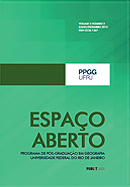Access to the City: Euclidean Distance to Social Variables of Interest, Chapecó – SC
DOI:
https://doi.org/10.36403/espacoaberto.2023.60188Keywords:
Access to the City, Euclidean Distance, Urban Land Use, Geographic Information SystemAbstract
Access to the city is a condition that indicates the population’s ability to engage in urban activities. Different locations have varying distances to social interest activities,
which is one of the factors of inequality. Understanding the levels of access in a city allows for strategic planning to address the needs of each locality. In this study, we assess
how each neighborhood in the city of Chapecó – SC accesses variables of social interest. To identify the variables, we conducted a mapping of Urban Land Use, followed by calculating the average distances per neighborhood using the techniques of Euclidean distance and zonal statistics. The results demonstrate significant differences in access to city infrastructure among the neighborhoods of Chapecó, with the periphery being notably the most affected region. Additionally, we observed that the use of Euclidean distances and zonal statistics helps in the investigating investigation of access differences.
Metrics
No metrics found.
Downloads
Published
How to Cite
Issue
Section
License
Copyright (c) 2023 Macleidi Varnier, Ederson do Nascimento, Laurindo Antonio Guasselli

This work is licensed under a Creative Commons Attribution-NonCommercial-ShareAlike 4.0 International License.


